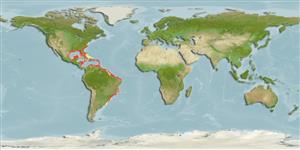>
Anguilliformes (Eels and morays) >
Muraenidae (Moray eels) > Muraeninae
Etymology: Gymnothorax: Greek, gymnos = naked + Greek, thorax, -akos = breast (Ref. 45335).
More on author: Agassiz.
Environment: milieu / climate zone / profondeur / distribution range
Écologie
marin; saumâtre récifal; profondeur 1 - 160 m (Ref. 9710), usually 1 - 100 m (Ref. 42064). Tropical
Western Atlantic: Greater Antilles, including the Central American coast from Nicaragua to northern coast of South America.
Taille / Poids / Âge
Maturité: Lm ? range ? - ? cm
Max length : 90.0 cm TL mâle / non sexé; (Ref. 57911); common length : 40.0 cm TL mâle / non sexé; (Ref. 6077)
Regularly spaced blackish spots on dorsal fin; anal fin with a series of black and white areas; gill opening roundish and located on midside of body; corner of mouth and gill-opening not black (Ref. 13608).
Body shape (shape guide): eel-like.
A solitary species (Ref. 26340) commonly found on deep soft bottom areas and banks, rarely on coral reefs (Ref. 9710). Also in estuaries and lagoons (Ref. 42064). Feeds mainly on crustaceans (Ref. 42064). Probably consumed fresh or salted (Ref. 3255).
Life cycle and mating behavior
Maturité | Reproduction | Frai | Œufs | Fécondité | Larves
Reproduction probably similar to Gymnothorax funebris (Ref. 42064).
Claro, R., 1994. Características generales de la ictiofauna. p. 55-70. In R. Claro (ed.) Ecología de los peces marinos de Cuba. Instituto de Oceanología Academia de Ciencias de Cuba and Centro de Investigaciones de Quintana Roo. (Ref. 26340)
Statut dans la liste rouge de l'IUCN (Ref. 130435: Version 2025-1)
Menace pour l'homme
Harmless
Utilisations par l'homme
Pêcheries: intérêt commercial mineur
Outils
Articles particuliers
Télécharger en XML
Sources Internet
Estimates based on models
Preferred temperature (Réf.
123201): 21.4 - 28, mean 25.9 °C (based on 1234 cells).
Phylogenetic diversity index (Réf.
82804): PD
50 = 0.5000 [Uniqueness, from 0.5 = low to 2.0 = high].
Bayesian length-weight: a=0.00045 (0.00028 - 0.00072), b=3.29 (3.16 - 3.42), in cm total length, based on LWR estimates for this species & Genus-body shape (Ref.
93245).
Niveau trophique (Réf.
69278): 4.1 ±0.71 se; based on food items.
Résilience (Réf.
120179): Faible, temps minimum de doublement de population : 4,5 à 14 années (Preliminary K or Fecundity.).
Fishing Vulnerability (Ref.
59153): High vulnerability (56 of 100).
🛈
Nutrients (Ref.
124155): Calcium = 25.8 [14.0, 53.6] mg/100g; Iron = 0.415 [0.245, 0.796] mg/100g; Protein = 19 [17, 22] %; Omega3 = 0.13 [0.06, 0.36] g/100g; Selenium = 52.5 [27.0, 102.7] μg/100g; VitaminA = 58.1 [17.2, 212.8] μg/100g; Zinc = 0.997 [0.697, 1.396] mg/100g (wet weight);
